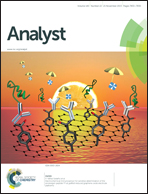An enzyme-free colorimetric assay using hybridization chain reaction amplification and split aptamers†
Abstract
A novel unmodified gold nanoparticle (AuNP)-based colorimetric assay was demonstrated using split aptamers and the hybridization chain reaction (HCR) amplification strategy. Here, the aptamer was divided into a structure-switching hairpin probe (DNA probe H1 (or H1′)) and a single-stranded probe (DNA probe H2 (or H2′)). In the presence of the target, DNA probe H1 (or H1′) could specifically capture the target with the assistance of DNA probe H2 (or H2′) to form a stable complex. Subsequently, the hairpin structure of DNA probe H1 (or H1′) was changed, and then a chain reaction of hybridization events between two other hairpin probes (H3 and H4) propagated, resulting in the formation of nicked double-helices. Since it was difficult for such nicked double-helices to inhibit salt-induced AuNP aggregation, a red-to-blue color change was observed. With the elegant amplification effect of HCR, this assay showed a low detection limit (15 nM for Hg2+ and 1 μM for adenosine), which was lower than or at least comparable to previous AuNP-based methods. The novel strategy not only eliminated the requirements of enzymatic reactions, separation processes, chemical modifications, and sophisticated instruments, but also could be used for other targets only by simply changing the DNA probe sequences.


 Please wait while we load your content...
Please wait while we load your content...